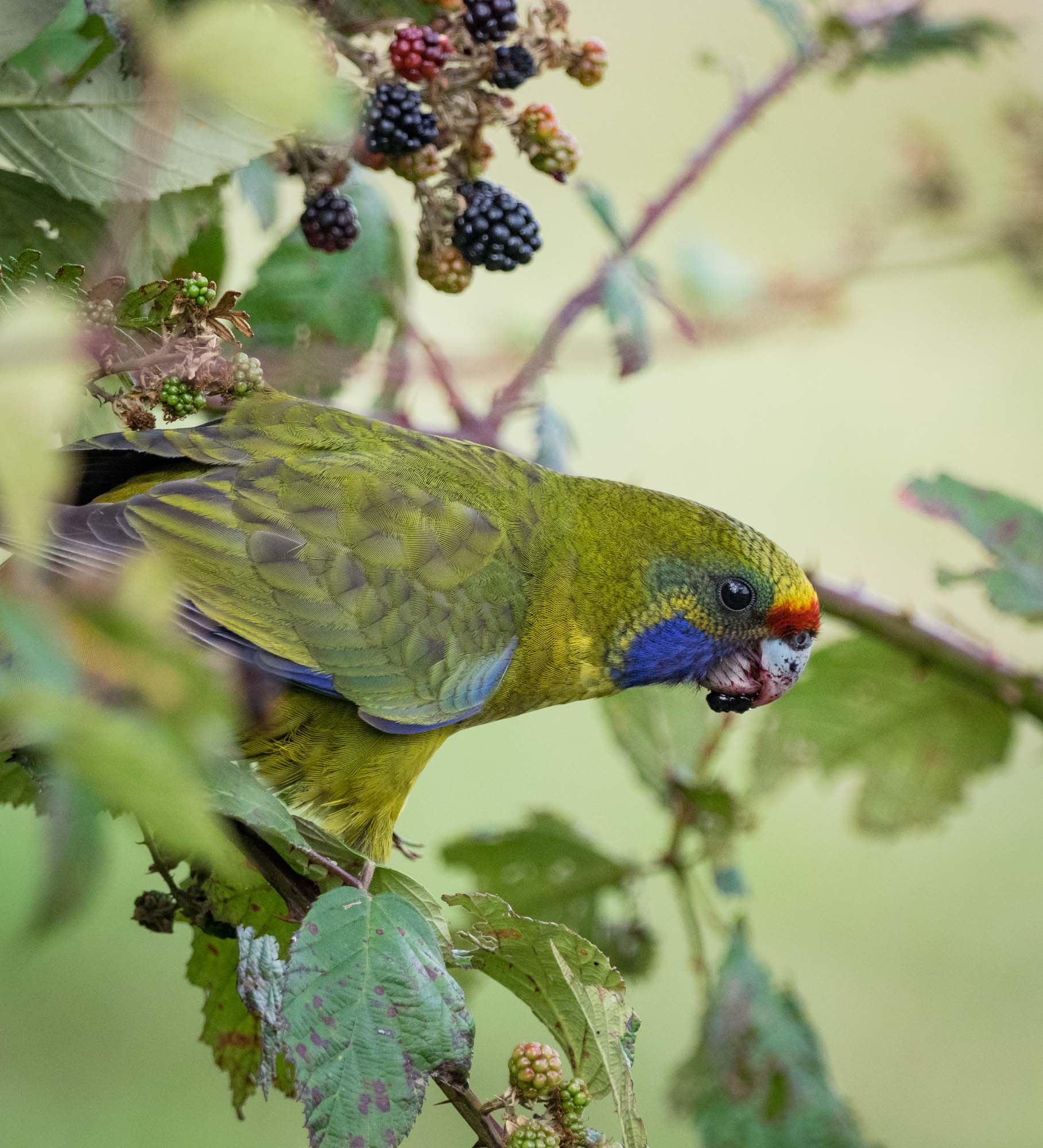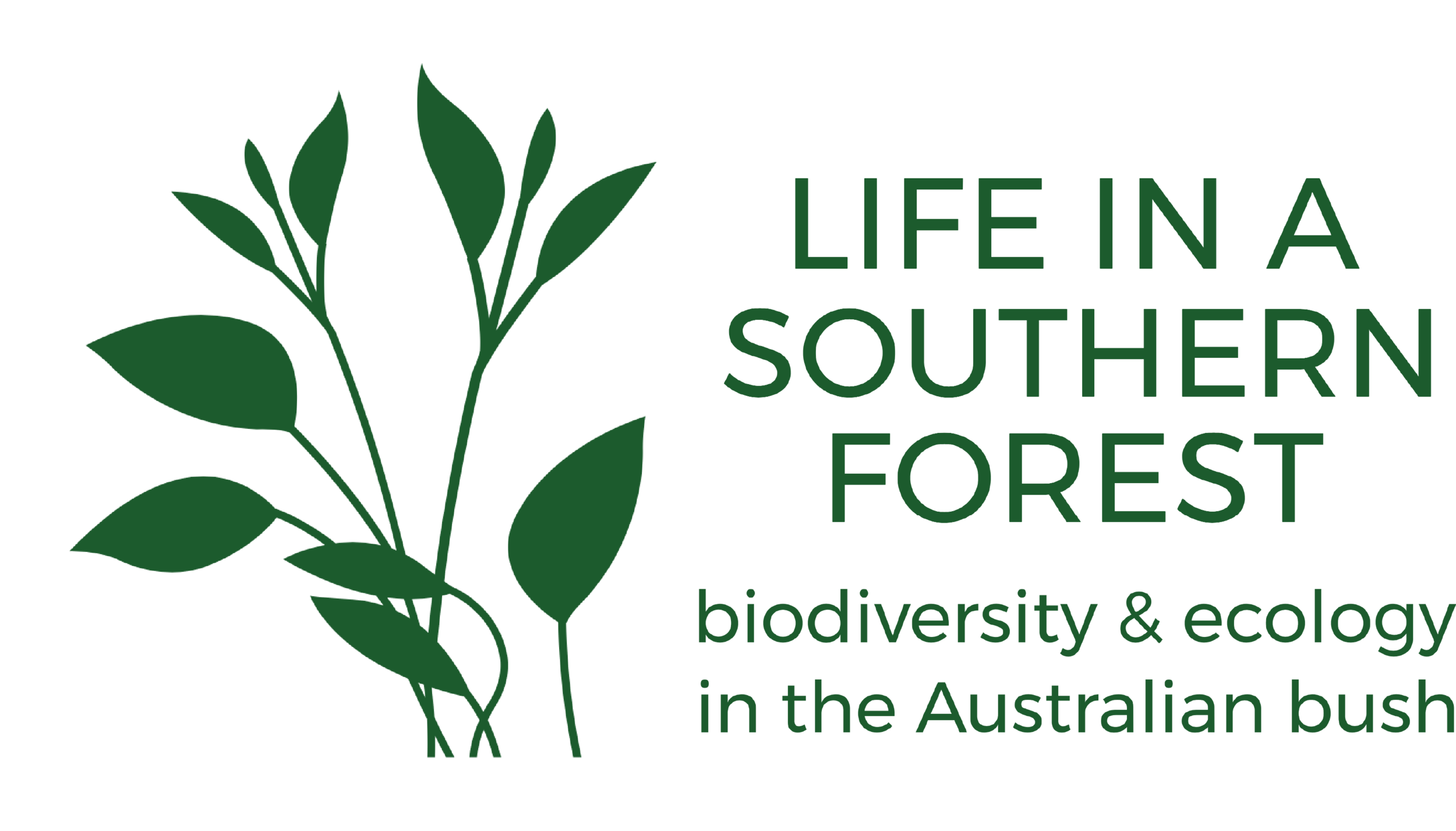
Pink Robin (female)
Although not an endemic, Tasmania is the stronghold for this tiny bird. And this was a 'first' for us! The females are very difficult to tell apart from other robins. The males, however ...
Species: Petroica rodinogaster
Mt. Field National Park

Pink Robin (male)
Our first-ever sighting of this stunning bird! The males are wary and secretive. While the immatures and females were busily feeding on the ground, this adult male left the cover of the trees only briefly - and was constantly on the lookout for ravens and currawongs.
Species: Petroica rodinogaster
Mt. Field National Park

Black Currawong
A Tasmanian endemic (i.e. not found elsewhere). This species has less white than the other two currawongs (Pied and Grey) and a particularly massive beak!
Species: Streptera fulignosa
Mt. Field National Park

Green Rosella (juvenile)
Another Tasmanian endemic, and seen throughout the state - here feasting on blackberries. Juveniles are green, while the adults are mainly yellow with blue-black wings and back.
Species: Platycercus caledonicus
Lucaston, Huon Valley

Mountain Heath Dragon
The only member of this genus and the only 'dragon' in Tasmania, this species also occurs in parts of Vic & NSW. It varies in colour from grey to brick-red. And we now realise that some of the grey 'Jacky Lizards' we have sighted at home are actually Mountain Heath Dragons. That's another one for the home list!
Family: Agamidae; Species: Rankinia diemensis
Freycinet National Park

Spotted (or 'Ocellated') Skink
Another Tassie endemic! This species is found in rocky lowland areas of eastern Tasmania and offshore islands. It was one of the many skink and lizard species we saw during a warm-weather walk along the rocky coastal fringe of Freycinet.
Family: Scincidae; Species: Carinascincus ocellatus
Freycinet National Park

Superb Fairy-wren (eclipse male)
This common wren of Australia's south-east is Tasmania's only fairy wren species. The island's population is considered a distinct sub-species.
Sub-species: Malurus cyaneus cyaneus
Mt Field National Park

Superb Fairy-wren (female)
Fairy-wrens favour habitats where dense bushes grow adjacent to open grasslands. For this reason they are quick to take advantage of urban gardens and farmland. This female was dashing in and out of roadside blackberries, a safe retreat from marauding currawongs and kookaburras.
Sub-species: Malurus cyaneus cyaneus
Lucaston, Huon Valley

Scarlet Robin (immature male)
Another species which has adapted well to farmland but only where there is tree cover nearby. The Tasmanian population is considered a distinct sub-species.
Sub-species: Petroica boodang leggii
Lucaston, Huon Valley

Garden Katydid (nymph)
This is the same species we commonly see at home. Nymphs may be red when young, but this one has probably reached the final juvenile stage. Its next moult will reveal a fully-winged adult.
Family: Tettigoniidae; Species: Caedicia simplex
Peter Murrell Reserve, Huon Valley

Garden Katydid
Katydids (Tettigoniidae) are easy to distinguish from grasshoppers (Family Acrididae) by their incredibly long antennae.
Family: Tettigoniidae; Species: Caedicia simplex
Peter Murrell Reserve, Huon Valley

Reed Bee
Some of the most obvious insects in Tasmania are introduced species. Honey bees and bumble bees abound, particularly in the apple-growing areas of the Huon Valley. And, worryingly, we saw European Wasps everywhere, including in the national parks at Mt Field and Lake Pedder. Yet a closer look also revealed many native bees and wasp species, such as this tiny Reed Bee.
Family: Apidae; Species: Exoneura sp.
Lucaston, Huon Valley

Wasp-mimic bee (female)
Many bees in this family can be easily mistaken for wasps, but perhaps none more so than this species. Even the wings appear folded and wasp-like! It is distributed along the east coast, from southern QLD to Tasmania.
Family: Colletidae; Species: Hyleoides concinna
Lucaston, Huon Valley

Wasp-mimic bee (male & female)
I spent a (happy!) hour or more in a friend's garden, watching a range of native bees and wasps feeding on Banksia. Several yellow-masked males were attracted to this large female - although she appeared to be quite oblivious as she dived for the plant's nectar.
Family: Colletidae; Species: Hyleoides concinna
Lucaston, Huon Valley

Tasmanian Scrubwren
Like its mainland counterpart, the White-browed Scrubwren (Sericornis frontalis), this Tasmanian endemic favours dense undergrowth. We came upon this individual just after it had bathed in a rainforest creek, affording us a rare, colourful view of the otherwise brown plumage.
Species: Sericornis humilis
Mt Field National Park

Silvereye
Tasmania's Silvereye is remarkably colourful. The rich red flanks distinguish this sub-species from the many mainland populations.
Sub-species: Zosteris lateralis lateralis
Crabtree Creek, Huon Valley

Tasmanian Thornbill
Now, is this the Brown or the Tasmanian Thornbill? Tricky!! Both species are found throughout Tasmania, and the differences are subtle. Based on the rich brown flight feathers I'm saying 'Tasmanian' for this one ... but I could be wrong.
Species: Acanthiza ewingii
(or sub-species Acanthiza pusilla diemenensis if it's the Brown)
Mt Field National Park

Tasmanian Froglet?
Another tricky identification. This loudly-calling male is either the Common Froglet (Crinia signifera) or the endemic, Tasmanian Froglet (Crinia tasmaniensis). Foolishly, I didn't record its call.
Species: Crinia sp.
Lucaston, Huon Valley
(What looks like a mid-dorsal stripe in this photo is actually the shadow from a reed - photos can sometimes be misleading!)

Lesser Tasmanian Darner
One of five dragonfly species found only in Tasmania, and yet another 'first' for us.
Order: Odonata; Family: Telephlebiidae; Species: Austroaeschna hardyi
Mt Field National Park

Lesser Tasmanian Darner
This male was guarding a stretch of rainforest-lined creek, just downstream from a waterfall.
Order: Odonata; Family: Telephlebiidae; Species: Austroaeschna hardyi
Mt Field National Park

Lesser Tasmanian Darner
Another male, guarding a patch further downstream.
Order: Odonata; Family: Telephlebiidae; Species: Austroaeschna hardyi
Mt Field National Park

Blue Ringtail
Tasmania has 29 species of dragonfly and damselfly. Most, like this one, are also found on the mainland.
Order: Odonata; Family: Lestidae; Species: Austrolestes annulosus
Lake Pedder

Eastern Swamp Emerald
On a small farm dam at our friends' home I discovered six species of dragonflies and damselflies. Although the distribution of this one includes Victoria, it was yet another 'first' for my Odonata list!
Order: Odonata; Family: Hemicorduliidae; Species: Procordulia jacksoniensis
Lucaston, Huon Valley

Blue-spotted Hawker
Dragonflies in this family are strong fliers and rarely land. They therefore represent quite a photography challenge ... unless you catch one egg-laying! This female was probing with her abdomen, inserting eggs into the submerged vegetation.
Order: Odonata; Family: Aeshnidae; Species: Adversaeschna brevistyla
Lucaston, Huon Valley
























